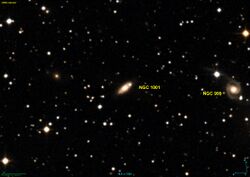Astronomy:NGC 1001
From HandWiki
Short description: Galaxy in the constellation Perseus
Coordinates: ![]() 02h 39m 12.66965s, +41° 40′ 18.1097″
02h 39m 12.66965s, +41° 40′ 18.1097″
| {{{name}}} | |
|---|---|
 DSS image of NGC 1001 | |
| Observation data (J2000 epoch) | |
| Constellation | Perseus |
| Right ascension | 02h 39m 12.66965s[1] |
| Declination | +41° 40′ 18.1097″[1] |
| Redshift | 0.015591[2] |
| Helio radial velocity | 4638 ± 23 km/s[2] |
| Distance | 206.6 Mly (63.33 Mpc)[3] |
| Apparent magnitude (B) | 14.7[2] |
| Characteristics | |
| Type | (R')S(s)0/a?[4] |
| Apparent size (V) | 0.740′ × 0.355′[2] |
| Other designations | |
| MCG+07-06-050, PGC 10050[2] | |
NGC 1001 is an unbarred spiral galaxy in the constellation Perseus.[5] It was discovered on December 8, 1871 by the astronomer Édouard Stephan.[4]
References
- ↑ 1.0 1.1 Brown, A. G. A. (August 2018). "Gaia Data Release 2: Summary of the contents and survey properties". Astronomy & Astrophysics 616: A1. doi:10.1051/0004-6361/201833051. Bibcode: 2018A&A...616A...1G.
- ↑ 2.0 2.1 2.2 2.3 2.4 "NGC 1001". SIMBAD. Centre de données astronomiques de Strasbourg. http://simbad.u-strasbg.fr/simbad/sim-basic?Ident=NGC+1001.
- ↑ Crook, Aidan C.; Huchra, John P.; Martimbeau, Nathalie; Masters, Karen L.; Jarrett, Tom; Macri, Lucas M. (2007). "Groups of Galaxies in the Two Micron All Sky Redshift Survey". The Astrophysical Journal 655 (2): 790–813. doi:10.1086/510201. Bibcode: 2007ApJ...655..790C.
- ↑ 4.0 4.1 Seligman, Courtney. "New General Catalogue objects: NGC 1000 - 1049". http://cseligman.com/text/atlas/ngc10.htm#1001. Retrieved 2021-04-17.
- ↑ "NGC 1001 - Spiral Galaxy in Perseus | TheSkyLive.com". https://theskylive.com/sky/deepsky/ngc1001-object.
 |

